Abstract
A parallel planetary gear train design is proposed to construct the wind turbine system that has double inputs and one output. The proposed system is flexible for the application, which may use a combination of two rotors, as used for horizontal axis or vertical axis wind turbines. The proposed transmission mechanism merges the dual time varied input wind powers to a synchronous generator. The effect of the gear train parameters on the dynamic power flow variation is modeled and simulated for the proposed wind turbine system. Results indicate the proposed planetary gear train system is a feasible and efficient design for its application to wind turbine systems. The dynamic torque equilibrium equations between meshed gear pairs are employed to analyze the dynamic power flow. The nonlinear behavior of a synchronous generator is also included in the modeling. The dynamic responses of the dual input transmission mechanism are simulated using the 4th order Runge–Kutta method. The study also investigates the effect of system parameters used in this wind turbine system (i.e., the wind speed, the magnetic flux synchronous generator, and the inertia of flywheels) on variations in electrical power output.
1. Introduction
Global interest in renewable energies has surged in recent years, and the development of green technologies has encouraged the applications of renewable energies to promote energy feasibility and reduce carbon emissions. In 2005, Cetin et al. [1] investigated the effects of blade number and angle for wind turbine systems and proposed a tip speed ratio (TSR) to optimize wind power efficiency. Chen [2] studied the influence of turbine blades with a pre-twisted angle on the turbine efficiency and the wind speed distribution. In 2007, Bunlung [3] studied the aerodynamic influence of wind speed on the starting torque for wind turbine systems. The majority of such systems transmit power using planetary gear systems based on the analysis conducted in 1972 by Freudenstein and Yang [4]. In that study, the kinematics, forces, and power flow for the planetary systems were widely discussed. Using the finite element method, in 1996, Velex and Flamand built a three-dimensional model for a planetary gear system to investigate the system’s dynamic responses and tooth load sharing [5]. Houser et al. [6] proposed five kinds for the gear systems characterized by their mesh parameters, including mesh stiffness, damping ratio, frictional coefficients, etc. To stabilize the system’s angular velocities and output torques, Chang [7] designed a variable inertia flywheel for a planetary gear system composed of a shaft and spring. Van de Ven [8] proposed another, fluid-controlled variable inertial flywheel to investigate the energy states for planetary gear systems. The influence of variable wind conditions on the wind turbine was studied by Hasan and Junejo [9], and the corresponding control system was designed and modelled.
Among renewable energy sources, the small wind turbine (SWT), used in rural or urban areas, has the advantages of easy accessibility, flexible capacity, and low costs. According to IEC 61400-2:2013 [10], the small wind turbine has a power output of less than 50 kW, and the corresponding rotor swept area is less than 200 m2. The SWTs used in urban or rural areas were studied in different countries, such as the United Kingdom [11], Kenya [12], and Venezuela [13], etc. It showed that the wind conditions have a strong effect on the effectiveness of SWTs. In the study by Anup et al. [14], it was suggested that the classification of the urban wind conditions should be revised for IEC 61400-2, and the small wind turbines could be designed to be more consistent with wind conditions in the urban environment. In the study by Battisti et al. [15], the small wind turbine effectiveness in the urban environment was discussed in relation to the wind fluctuation. Both the vertical axis wind turbine (VAWT) and horizontal axis wind turbine (HATW) were investigated for the trend of rotor inertia versus radius, the response time of rotor inertia to the wind fluctuation, and the corresponding control strategy, etc. In 2019, Wu et al. [16] tested the performance of the small VAWTs with the nominal powers of 1 kW and 3 kW. The maximum power outputs were 0.69 kW and 1.6 kW at the wind speeds of 14.5 m/s and 10.5 m/s for the 1 kW and 3 kW VAWTs, respectively. It also pointed out that the VAWTs enabled the braking mechanism when the wind speed was over the prescribed wind limit. The results showed that the real outputs were far less than the nominal powers for the commercial wind turbines in the market. To accurately estimate the influence of the wind condition in the urban area, Carbo Molina et al. [17] developed the tunnel test for VAWTs in the turbulent flows. Using the aeroelastic model, Evans et al. [18] analyzed the horizontal-axis wind turbine of 5 kW. Compared to VAWTs, HAWTs are more sensitive to wind fluctuation. In 2013, Kot et al. [19] studied the maximum peak power tracking (MPPT) algorithm for a HAWT with a permanent magnet synchronous generator (PMSG) of 5 kW. Innovative types of wind turbines were also proposed for the application in the rural or urban areas, such as shrouded- and twin-rotor wind turbines [20], small-scale orthopter-type vertical axis wind turbines [21], and small wind energy portable turbines (SWEPTs) [22], etc.
As shown in the reference [23], the epicyclic mechanism with two inputs is illustrated as a standard example. However, the design and application for the wind turbine in a real situation are very flexible. In 2020, Huang and Zhang [24] proposed an accelerator of planetary gear for wind turbine systems and analyzed the effects of the parameters of the planetary gear on conversion efficiency. In this study by Anekar et al. [25], the mechanism of planetary helical gear system was used to study its application for wind power plants with the features of heavy load and low noise. Combined with a differential planetary gear train, Klimina and Shalimova [26] proposed a counter-rotating HAWT of dual propellers. In the proposed model, one of the dual propellers carried the rotor of the generator, and the other propeller carried the stator of the generator.
In this study, a double-set planetary mechanism of gear trains is proposed as a dual input module for a small wind turbine system. The proposed system may use the mixture of rotors as used for HAWTs and VAWTs. The power flow of the dual input mechanism was analyzed, and the system’s starting torque is discussed. In addition, the feasibility of a variable inertia flywheel was investigated for the small wind turbine system.
2. Mathematical Model for a Small Wind Turbine System
In this study, a small wind turbine system includes elements such as turbine blades, gear train mechanism, and alternator. The mathematical model for each component is described below.
2.1. Wind Power Model
For a small wind turbine system, the power absorbed by the blades is determined by wind speed, blade parameters, and wind power coefficient. According to Guey [9], the effective power input for the proposed dual input transmission mechanism can expressed as
where is the power input (W), the radius of the blade (m), the air density (kg/m3), and is the speed of the wind through the blades (m/s). The wind power coefficient is a function of the blade angle and tip speed ratio (TSR), which is defined as the speed of the blade tip divided by the wind speed. For a given wind speed, the value of determines the absorption efficiency of wind power for the wind turbine system. The empirical formula for can be written as
and
where is the blade angle and is TSR. Figure 1 shows the wind power coefficient variation for different blade angles. For a given blade angle, there exists a TSR at which the wind power coefficient reaches its maximum value.
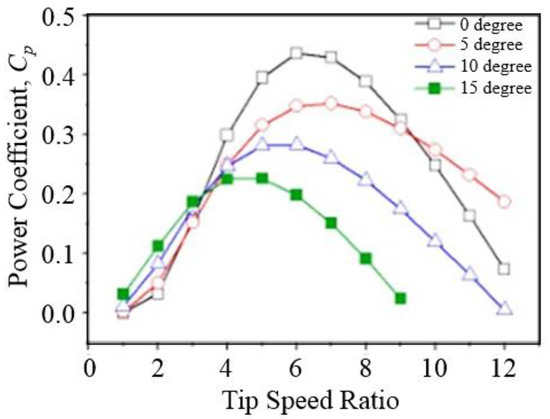
Figure 1.
Wind power coefficient variation for different blade angles.
For , Figure 2 shows the variations of the wind power coefficient and power input for different wind speeds. The power input and the power coefficient are seen to reach their maximum values at different wind speeds.
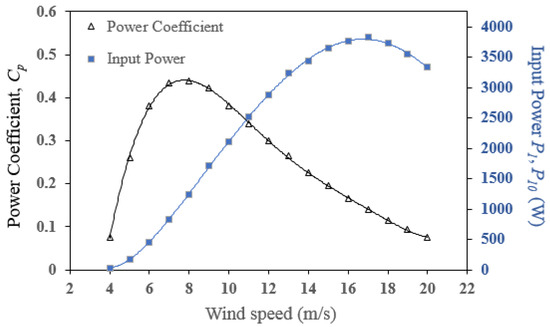
Figure 2.
Wind power coefficient and input variations for different wind speeds.
2.2. Synchronous Generator
Synchronous generators were used to transform mechanical energy into electrical energy. In a synchronous generator, the magnetic field is built by supplying DC current to the rotor. When the rotor is operating, the induced voltage is produced in the stator. Figure 3 shows a circuit diagram for a synchronous generator.
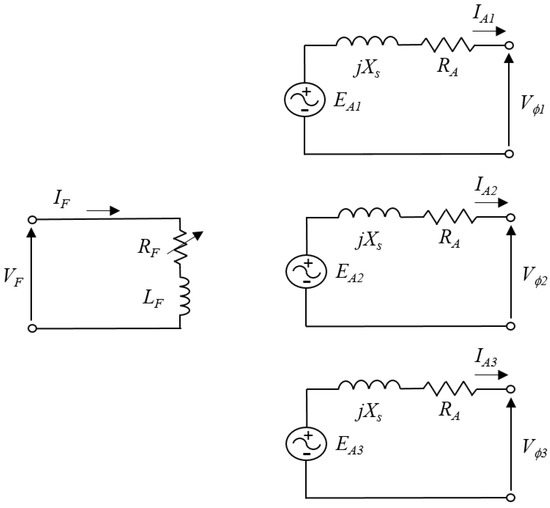
Figure 3.
Circuit for synchronous generator.
In this study, the synchronous generator is simulated as a pre-phase equivalent circuit, as shown in Figure 4. The output power of the synchronous generator [27] can be derived as
where is the generator’s output power (W), is the torque induced on the input shaft of the generator (N-m), is the angular speed of the generator’s input shaft (rad/s), is the generator’s single-phase voltage output (V), is the induced voltage (V), is the torque angle, and is the impedance of the generator circuit. As shown in Equation (4), the induced torque is determined by the angular speed of the generator shaft. Equation (4) is incorporated into the governing equations for the dual input transmission mechanism for the whole wind turbine system.

Figure 4.
The pre-phase equivalent circuit for synchronous generator.
2.3. Gear Train Mechanism
The dual input transmission mechanism is shown in Figure 5.
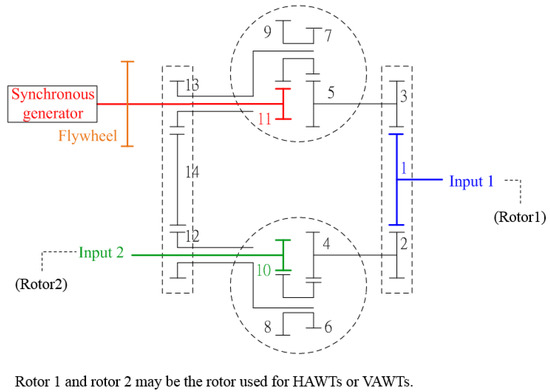
Figure 5.
Dual input transmission mechanism.
In the figure, the planetary gear sets are marked by two circles of dashed lines. The proposed mechanism integrates the two planetary gear trains as inputs for a single output and introduces a variable inertial flywheel. The governing equations for the system can be derived as below.
where the subscripts are used for the gear numbers; , , and are the polar mass, mass, angular acceleration, and pitch diameter for gear , respectively; is the polar mass of the turbine at the input 1; is the input torque produced by the wind; is the tangential force between gear and gear ; and are the tangential forces from the arms of the planetary gear trains. For the planetary gear trains, the equations of motion can be derived as
where is the polar mass of the turbine at the input 2 and is the polar mass of the synchronous generator. Generally, is negligible. The variable inertia of the flywheel is represented by . is the second input of the dual input transmission mechanism. According to the angular speed , is the output torque induced by the synchronous generator, as shown in Equation (4).
2.4. Adjustable Flywheel Mechanism
Figure 6 shows the design of a proposed variable inertial flywheel. The flywheel is an assembly of spring, sliding mass, and shaft. The inertia of the flywheel is determined by the angular speed of the shaft. For a small wind turbine system, the flywheel is used as an energy-storing component, which can stabilize the system output. The inertia of the flywheel consists of the base disc and sliding mass parts.
where are the inertias for the whole flywheel, base disc, and sliding mass, respectively. The radius of gyration can be expressed as
where is the radius of gyration, is the length of the linkage, is the spring constant, is the original length of the spring, is the mass of the sliding block, and is the angular speed of the flywheel. For the proposed flywheel mechanism, the inertia of the flywheel increases with the angular speed.
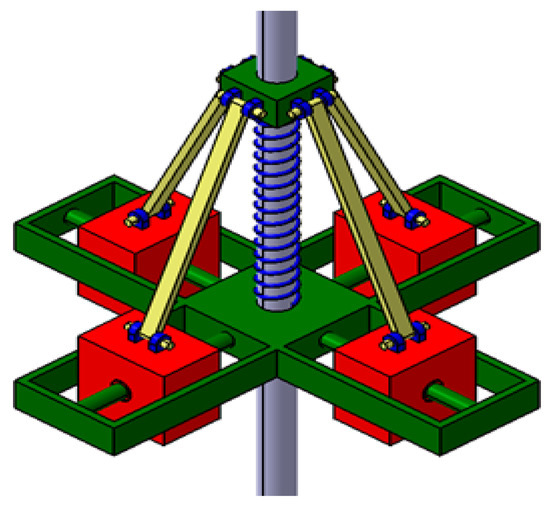
Figure 6.
Variable inertial flywheel design.
When the flywheel rotates, the sliding mass will move outwards and compress the spring, which stores potential energy. As the rotating speed increases, more potential energy is stored in the spring. This potential energy is released as the angular speed decreases. For a small wind turbine system, the proposed flywheel mechanism simultaneously stores and adjusts the kinetic and potential energies.
3. Computational Algorithm
In reality, wind speed varies over time. For application in a small wind turbine system, the wind speed variation must fall within an acceptable range. In our simulation, the cut-in wind speed must be large enough to start the wind turbine system. At that moment, the dual input transmission mechanism begins to drive the synchronous generator. When the cut-out wind speed is reached, the mechanism will trip out to protect the synchronous generator. Thus, the operating wind speed must lie between the cut-in and cut-out wind speeds. The wind speed is sampled once every ten minutes. The Runge–Kutta method is used to simulate the small wind turbine system and the computational algorithm is shown in Figure 7.
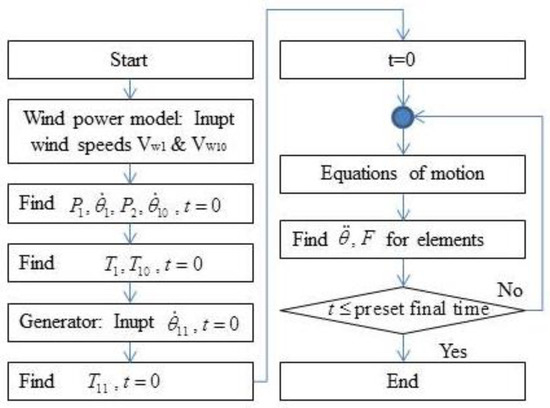
Figure 7.
Computational algorithm.
In the simulation, the convergence of the Runge-Kutta method is performed, with the energy error term defined as
The energy error term is found to approach zero as the time interval approaches 0.2 (s). Thus, the simulation has 3000 steps in 10 min.
4. Numerical Results and Discussion
Figure 8 shows the input power variations for different wind speeds. Given a sampling frequency of once every ten minutes, the wind speed variation assumes a step form in the simulation. Table 1 and Table 2 list the data for the gear used in this study.

Figure 8.
Steps form for the wind speed simulation.

Table 1.
Gear number.

Table 2.
Gear module and face width.
4.1. Magnetic Flux Control and Power Flow Analysis
For a wind turbine system, the induced output torque is influenced by the magnetic flux of the rotor. In particular, in low winds, the input power will fail to produce enough output torque to drive the generator. In this study, the synchronous generator is capable of controlling the magnetic flux, which can be expressed in terms of a preset operating speed.
where is the magnetic flux (). The parameter is
where and are respectively the actual angular speed and the preset operating speed for the output shaft. In this study, the allowable variation range of the magnetic flux is of 0.3. Figure 9 shows the variation of the magnetic flux vs. the angular speed .

Figure 9.
Magnetic flux variation for the generator.
As shown in Figure 10, the wind speed assumes a step-like form, and the corresponding output powers are presented for constant and variable magnetic flux cases. It is found that the output power varies little in cases of constant and variable magnetic flux. At the starting of the wind turbine system, the wind speed is about 4 m/s.
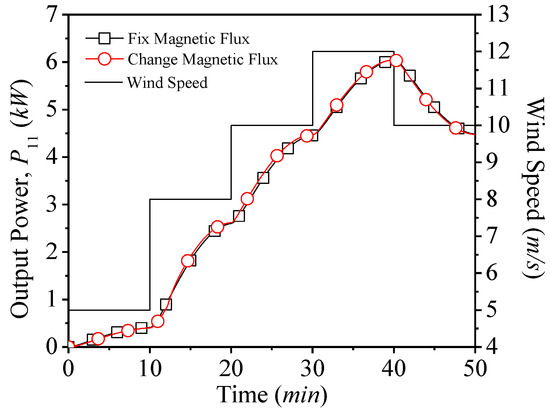
Figure 10.
Output power variation at different wind speeds.
Figure 11 and Figure 12 show the angular speed and torque variations for the output shaft. A higher angular speed and lower induced torque are found on the output shaft at the starting stage for the variable magnetic flux case. As shown in Equation (18), the magnetic flux is controlled within the acceptable range; thus, the output shaft’s angular speed will increase slowly to a stable value. As compared to the constant magnetic flux, the variable magnetic flux allows the system to operate in a stable state with lower angular speed and higher output torque. As shown in Figure 13 and Figure 14, similar results can be observed for the input shafts.
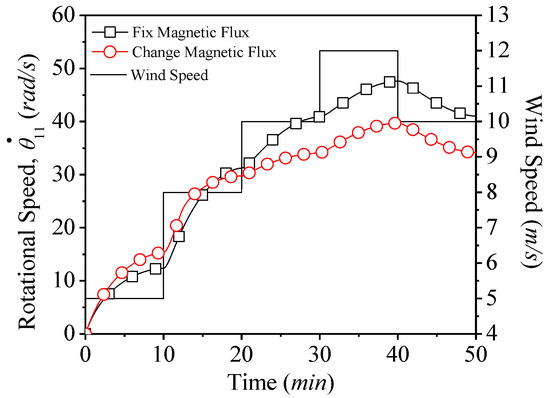
Figure 11.
Rotational speed variation for the output shaft.
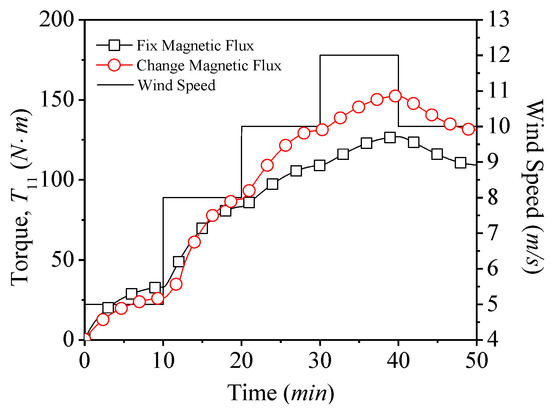
Figure 12.
Torque variation for the output shaft.
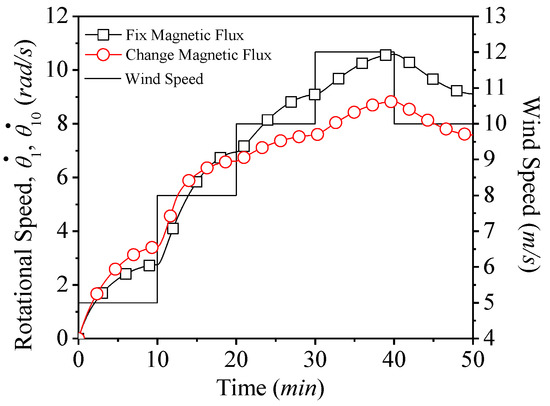
Figure 13.
Rotational variation for the input shaft.

Figure 14.
Torque variation for the input shaft.
Figure 15 shows the power flow for a wind speed of 9.5 m/s. In the case, two input powers of the proposed mechanism have the same value of 3.02 kW. At Input 1, the power splits as two branches of 2.01 kW and 1.01 kW for the upper and lower planetary gear trains, respectively. At the lower planetary gear train, a sub-total power of 4.03 kW flows into the upper planetary gear train, which gives the total output power of 6.04 kW. It is found that the dual inputs of wind power can be easily integrated for a single output by a feasible mechanical mechanism design, as the proposed system does.
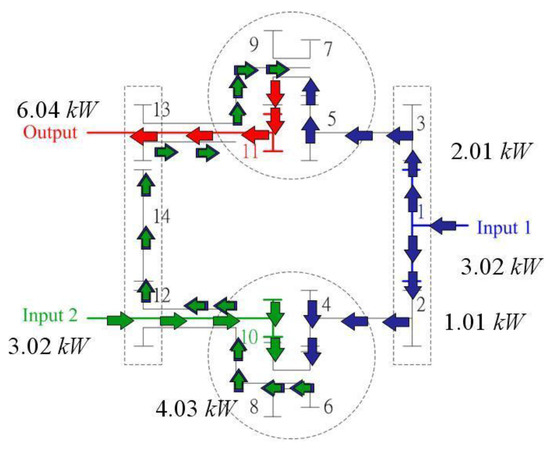
Figure 15.
Power flow analysis.
4.2. Variable Inertial Flywheel
The design parameters for the variable inertial flywheel (VIF) must consider the range of the shaft’s angular speed. Figure 16 shows the inertia variation for the flywheel. As shown in Figure 17, different input powers are applied to the system. Figure 18, Figure 19 and Figure 20 respectively show the corresponding power, angular speed, and torque variations for the output shaft, presenting the responses of the systems with and without VIF. Figure 18, Figure 19 and Figure 20 also show that, although the inertia of the flywheel is not sufficiently high, the system with VIF (shown by red rectangles in the figures) trends to stabilize the system responses, unlike the system without VIF (shown by black circles in the figures). This may be attributed to the proposed flywheel mechanism, which can be used to adjust the energy state for the wind turbine system.

Figure 16.
Inertial variation for the flywheel.
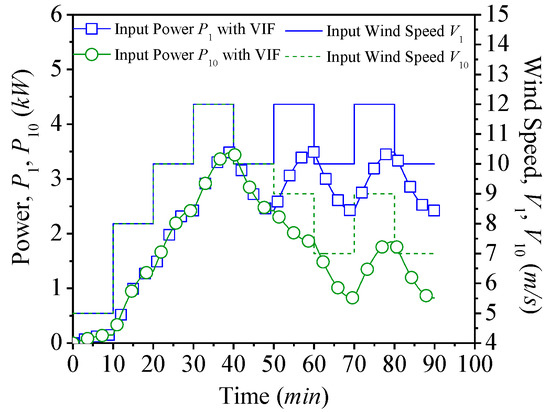
Figure 17.
Input powers variation.
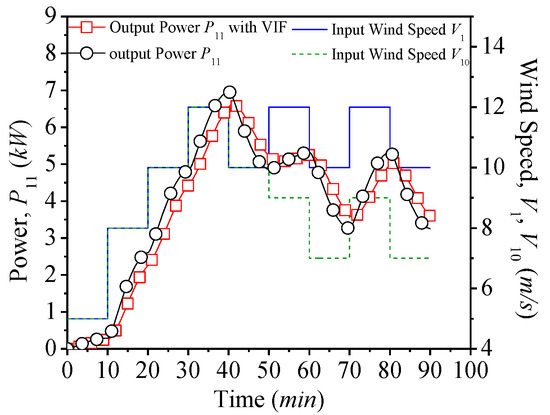
Figure 18.
Output power variation.
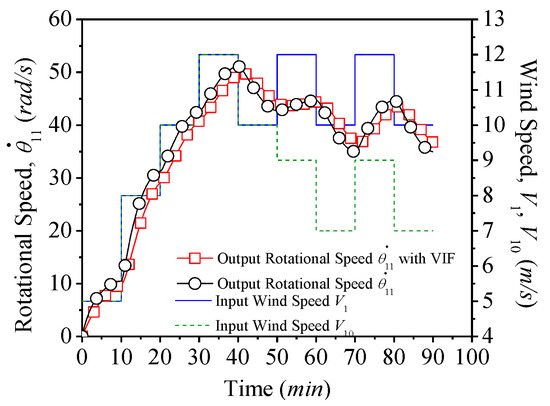
Figure 19.
Output rotational speed variation.

Figure 20.
Output torque variation.
5. Conclusions
A dual-input transmission mechanism is proposed for small turbine systems. The dual input transmission mechanism features two sets of planetary gear trains and a variable inertia flywheel for the analysis in this paper. Based on the conservation of energy, neglecting the loss of gear trains, the proposed system is capable of accepting the two rotors rotating in different directions and integrates the energy flows for the generator. However, in real situations, the transmission trains may use gears and/or other mechanical elements to build the proposed system, avoiding the wind interaction between the two rotors. Moreover, as shown in Figure 5, the rotor and the input axis may be separated as individual elements and connected by the belt for the power transmission, which produces the feasibility for a real installation case. In addition, in this study, a variable magnetic flux controlled by the synchronous generator is used to stabilize system responses, especially at startup. Numerical results show that the integration of the dual inputs can improve the turbine system’s performance, and the variable inertia flywheel stabilizes system responses. As stated in reference [16], the commercial small wind turbines have their real power output less than the nominal power. As the battery module is introduced for the purpose of energy storage for the SWT system, the combination of two rotor inputs can increase the power input, which may create a high voltage output for real application. With the proposed model, it gives the manufacturers of SWTs the idea to improve the performance of SWTs by the variations of mechanical mechanism, which enable the integration of energy flows. In conclusion, the proposed model is shown to provide a feasible solution for improving wind turbine performance.
Author Contributions
Conceptualization, J.-H.K.; software, A.-D.L.; validation, T.-P.H. and H.-A.T.; formal analysis, A.-D.L.; supervision, T.-P.H. All authors have read and agreed to the published version of the manuscript.
Funding
This research was funded by the Metal Industries Research & Development Center.
Conflicts of Interest
The authors declare no conflict of interest.
References
- Cetin, N.S.; Yurdusev, M.A.; Ata, R.; Özdemir, A. Assessment of optimum tip speed ratio of wind turbines. Math. Comput. Appl. 2005, 10, 147–154. [Google Scholar]
- Chen, K. Numerical Study of HAWT with Twisted Blade. Master’s Thesis, National Taiwan University of Science and Technology, Taipei, Taiwan, 2005. [Google Scholar]
- Bunlung, N.; Somporn, S.; Somchai, C. Development of a wind turbine simulator for wind generator testing. Int. Energy J. 2007, 8. Available online: http://www.rericjournal.ait.ac.th/index.php/reric/article/view/173 (accessed on 17 October 2020).
- Freudenstein, F.; Yang, A.T. Kinematics and Statics of a Coupled Epicyclic Spur-Gear Train. Mech. Mach. Theory 1972, 7, 263–275. [Google Scholar] [CrossRef]
- Velex, P.; Flamand, L. Dynamic Response of Planetary Trains to Mesh Parametric Excitations. J. Mech. Des. Trans. ASME 1996, 118, 7–14. [Google Scholar] [CrossRef]
- Özgüven, H.N.; Houser, D.R. Mathematical models used in gear dynamics—A review. J. Sound Vib. 1988, 121, 383–411. [Google Scholar] [CrossRef]
- Chang, H.C. Conceptual and Topological Design for Variable Moment of Inertia Flywheels. Master’s Thesis, Kun Shan University, Tainan, Taiwan, 2007. [Google Scholar]
- Van de Ven, J. Fluidic Variable Inertia Flywheel. In Proceedings of the 7th International Energy Conversion Engineering Conference, Denver, CO, USA, 2–5 August 2009. [Google Scholar]
- Hasan, W.U.I. Variable speed wind turbine control system: Design & Model. J. Indep. Stud. Res. Comput. 2010, 8, 44–51. [Google Scholar]
- IEC 61400-2:2013 Wind Turbines—Design Requirements for Small Wind Turbines. Available online: https://collections.iec.ch/std/series/iec61400-2%7Bed3.0%7Den.nsf/doc.xsp?open&documentId=E6E2B42DB46F6F2CC1257CD6005860F5 (accessed on 17 October 2020).
- Drew, D.R.; Barlow, J.F.; Cockerill, T.T. Estimating the potential yield of small wind turbines in urban areas: A case study for Greater London, UK. J. Wind Eng. Ind. Aerodyn. 2013, 115, 104–111. [Google Scholar] [CrossRef]
- Kamp, L.M.; Vanheule, L.F.I. Review of the small wind turbine sector in Kenya: Status and bottlenecks for growth. Renew. Sustain. Energy Rev. 2015, 49, 470–480. [Google Scholar] [CrossRef]
- Lopez-Gonzalez, A.; Ranaboldo, M.; Domenech, B.; Ferrer-Marti, L. Evaluation of small wind turbines for rural electrification: Case studies from extreme climatic conditions in Venezuela. Energy 2020, 209, 118450. [Google Scholar] [CrossRef]
- Anup, K.C.; Jonathan, W.; Tania, U. Urban wind conditions and small wind turbines in the built environment: A review. Renew. Energy 2019, 131, 268–283. [Google Scholar]
- Battisti, L.; Benini, A.; Brighenti, A.; Dell’Anna, S.; Raciti Castelli, M. Small wind turbine effectiveness in the urban environment. Renew. Energy 2018, 129, 102–113. [Google Scholar] [CrossRef]
- Wu, Y.K.; Lin, H.J.; Lin, J.H. Certification and testing technology for small wind turbine in Taiwan. Sustain. Energy Technol. Assess. 2019, 31, 34–42. [Google Scholar]
- Carbo Molina, A.; Bartoli, G.; De Troyer, T. Wind tunnel testing of small vertical-axis wind turbines in turbulent flows. Procedia Eng. 2017, 199, 3176–3181. [Google Scholar] [CrossRef]
- Evans, S.P.; Bradley, D.R.; Clausen, P.D. Development and experimental verification of a 5kW small wind turbine aeroelastic model. J. Wind Eng. Ind. Aerodyn. 2018, 181, 104–111. [Google Scholar] [CrossRef]
- Kot, R.; Rolak, M.; Malinowski, M. Comparison of maximum peak power tracking algorithm for a small wind turbine. Math. Comput. Simul. 2013, 91, 29–40. [Google Scholar] [CrossRef]
- Lipian, M.; Dobrev, I.; Massouh, F.; Jozwik, K. Small wind turbine argumentation: Numerical investigations of shrouded- and twin-rotor wind turbines. Energy 2020, 201, 11758. [Google Scholar] [CrossRef]
- ElCheikh, A.; Elkhoury, M.; Kiwata, T.; Kono, T. Performance analysis of a small-scale orthopter-type vertical axis wind turbine. J. Wind Eng. Ind. Aerodyn. 2018, 180, 19–33. [Google Scholar] [CrossRef]
- Kishore, R.A.; Pyria, S. Design and experimental verification of a high efficiency small wind energy portable turbine (SWEPT). J. Wind Eng. Ind. Aerodyn. 2013, 118, 12–19. [Google Scholar] [CrossRef]
- Martin, G.H. Epicyclics with Two Inputs: Kinematics and Dynamics in Machine; Waveland Press, Inc.: Long Grove, IL, USA, 2002; p. 284. [Google Scholar]
- Huang, Y.; Zhang, L. Design of planetary gears for wind power transmission mechanism. In International Conference on Applications and Techniques in Cyber Intelligence ATCI 2019; Abawajy, J., Choo, K.K., Islam, R., Xu, Z., Atiquzzaman, M., Eds.; Springer: Cham, Switzerland, 2020; Volume 1017. [Google Scholar] [CrossRef]
- Anekar, N.; Deshmukh, S.; Nimbalkar, S. Planetary Helical Gear System. In Proceedings of the International Conference of Science and Technology, Pune, India, 21–22 February 2014. [Google Scholar]
- Klimina, L.; Shalimova, E. Dual-propeller wind Turbine with a differential Planetary Gear. Mehatronika Avtom. Upr. 2017, 18, 679–684. [Google Scholar] [CrossRef]
- Knight, A. Power and Torque; Synchronous Machine. Available online: http://people.ucalgary.ca/~aknigh/electrical_machines/synchronous/s_power_torque.html (accessed on 6 October 2020).
Publisher’s Note: MDPI stays neutral with regard to jurisdictional claims in published maps and institutional affiliations. |
© 2020 by the authors. Licensee MDPI, Basel, Switzerland. This article is an open access article distributed under the terms and conditions of the Creative Commons Attribution (CC BY) license (http://creativecommons.org/licenses/by/4.0/).